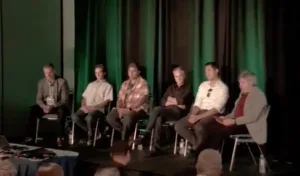During a panel discussion at SIGGRAPH 2016, James Mathers from The Digital Cinema Society chaired the following panel:
• Ted Schilowitz, Futurist at 20th Century FOX and Chief Creative Officer at Barco
• Bei Yang, Creative Technologies Leader at Walt Disney Imagineering
• Shiraz Akmal, Co-Founder and Chief Executive Officer of VR technology startup Spaces
• Larry Cutler, CTO and Co-Founder at VR Animation company Baobab Studios
• Michael Kaplan, Manager of Global Media & Entertainment Enterprise at NVidia
The panel took the term VR very widely and included technologies including VR, AR, Mixed Reality, 360 cinema, etc. In all these areas, telling a story in space is creating new challenges that are similar to the challenges cinema faced 100 years ago. Besides the terminology, it’s not clear how to use the existing tools for VR content creation from the story line to the implementation. “How does the director control what the consumer is looking at?” is one of the big questions VR is facing. While the discussion was mostly aimed at the creative side of the industry, NVidia pointed out that the hardware (graphic cards) is an essential part of the VR development as it limits what the system is able to support and consequently what the user will be able to see.
Several of the panelists pointed out that VR is just the extension of what 360º cinemas, panoramas, amusement parks, etc. are already trying to create. Telling a story and creating an environment that puts the consumer in the action is the ultimate goal of any attraction in a theme park. VR will be more like the real world. It will give the user cues on what to look at, but the user will be able to take different path to follow the storyline. In VR environments, the experience is something in between a movie and a game. People will do things differently but they will all get to the same point.
One observation is that the mix of interaction and passive entertainment may create issues for the viewer as they will not know what calls for activity and what does not. This is very similar to current video gaming, where the passive and active parts are clearly separated.
Currently, the industry creates VR experiences and takes the lessons from them to see what works and what does not and in this, it really mirrors the early years of cinema and TV. As we move forward the consumer’s expectation will change as well, as they learn more abut the VR medium. One key aspect is that VR is happening in real space. The viewer can manoeuvre through the virtual space, providing a sense of immersion that goes way beyond the feeling of space that was created by 3D content.
While there is more money flowing into the industry through investments, some of the early players are starting to make money from content sales. This does not come as a surprise, as more than a million early adopters having access to VR hardware and are looking for content to use their hardware. in addition, VR is moving beyond the position of being just a promotion tool for the large studios. They want to make money with VR, a healthy development in the long term.
One of the content creation issues is that content may work better on one hardware platform compared to another. Hardware devices are trying to differentiate from their competitors by doing certain things better than other devices. As a consequence, content needs to be developed with these specific aspects in mind.
Analyst Comment
Storytelling in VR or creating successful content for the VR platform is still very much at the beginning. This topic is being discussed widely and one can find almost every opinion expressed by one industry player or another. The range streches from ‘it is impossible’ to ‘so many new options’. VR is a new medium and basing it on lessons from cinema, gaming or TV is just the start. Certain things will work, others will not. The consumer will eventually make a decision on what format and story telling technique will work for VR. It will just take time. (NH)

